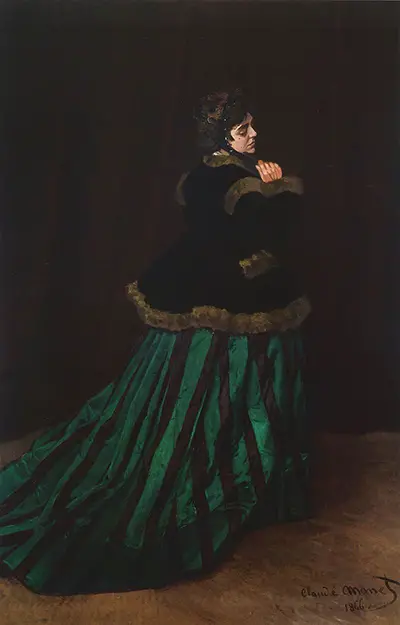The subject in the picture is the model Camille Doncieux. The painting is part of the collection that resides at the Kunsthalle, in Bremen.
In 1866 the artist Claude Monet's created The Woman in the Green Dress. The subject of the painting was his favourite model and mistress, Camille Doncieux. She later became his first wife and the mother of his two sons. The picture has an alternative title by which it’s also well-known - Camille.
In 1865 Monet was working on a very large painting (Luncheon on the Grass). His plan was to show it at the Paris Saloon gallery. As Monet worked on it, he feared that he would not complete it in time for the exhibition. Because of this, he stopped work on the painting.
In its place, Monet decided to create a large-sized portrait of his model, Camille. The aim was to enter this picture in ‘The Saloon’. The painting was accepted and appeared in the exhibition.
Art critics of the time were very positive of the painting. It gained him some well-received praise. The artwork was later sold for 800 Francs. For a somewhat new artist, this was a significant amount of money at the time.
In the painting Camille is wearing a green and black striped dress with a train as well a fur-trimmed jacket. The hat is an Empire bonnet.
By opting for the undefined dark background, Monet makes us focus on the model and the detail of what she is wearing. Camille looks as if she is about to exit the door and go for a walk. The context of the scene and situation is unclear as she has her back to us.
During his long career, Monet was an artist whose painting style we have come to associate with Impressionism. Despite this, his painting of The Woman in the Green Dress was different. It did not follow the Impressionist style.
The picture was something more associated with the style of Realism. Also, the portrait was unusual in that it was a life-sized portrait. Such paintings of this size often featured portraits of royals or other well-known persons.
Created in the Realist style, the method of painting employs the use of dark colours as well as a deep background. By the same token, the picture pays strong attention to the detail in the dress worn by the model, Camille. In his early years, many of the portraits that Monet’ created were more Realist than Impressionist in style.
During his lifetime Monet produced a number of works of art. Several of these works involved Camille Monet as his subject. As well as The Woman in the Green Dress she appears in such works as Women in the Garden, and Springtime for example. Camille was also the subject of paintings by Renoir and Manet.


